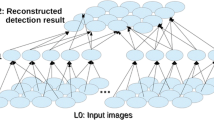Abstract
Detection of facial landmarks and accurate tracking of their shape are essential in real-time applications such as virtual makeup, where users can see the makeup’s effect by moving their face in diverse directions. Typical face tracking techniques detect facial landmarks and track them using a point tracker such as the Kanade-Lucas-Tomasi (KLT) point tracker. Typically, 5 or 64 points are used for tracking a face. Even though these points are enough to track the approximate locations of facial landmarks, they are not sufficient to track the exact shape of facial landmarks. In this paper, we propose a method that can track the exact shape of facial landmarks in real-time by combining a deep learning technique and a point tracker. We detect facial landmarks accurately using SegNet, which performs semantic segmentation based on deep learning. Edge points of detected landmarks are tracked using the KLT point tracker. In spite of its popularity, the KLT point tracker suffers from the point loss problem. We solve this problem by executing SegNet periodically to recalculate the shape of facial landmarks. That is, by combining the two techniques, we can avoid the computational overhead of SegNet and the point loss problem of the KLT point tracker, which leads to accurate real-time shape tracking. We performed several experiments to evaluate the performance of our method and report some of the results herein.















Similar content being viewed by others
References
Badrinarayanan V, Kendall A, Cipolla R (2017) Segnet: a deep convolutional encoder-decoder architecture for image segmentation. IEEE Trans Pattern Anal Mach Intell 39(12):2481–2495
Barber CB et al (1996) The quickhull algorithm for convex hulls. ACM Trans Math Softw (TOMS) 22(4):469–483
Belaroussi R, Prevost L, Milgram M (2005) Combining model-based classifiers for face localization. Ninth IAPR Conference on Machine Vision Applications, pp 290–293
Canny J (1986) A computational approach to edge detection. IEEE Trans Pattern Anal Mach Intell 8:679–698
Danelljan M et al (2017) Discriminative scale space tracking. IEEE Trans Pattern Anal Mach Intell 39(8):1561–1575
DEST v.08 software library (2016) http://github.com/cheind/dest/releases (visited on 15-12-16)
Girshick R (2015) Fast r-cnn. ArXiv preprint arXiv:1504.08083
Girshick R, Donahue J, Darrell T, Malik J (2014) Rich feature hierarchies for accurate object detection and semantic segmentation. Proceedings of the IEEE conference on computer vision and pattern recognition
Hare S, Golodetz S, Saffari A, Vineet V, Cheng MM, Hicks SL, Torr PH (2016) Struck: structured output tracking with kernels. IEEE Trans Pattern Anal Mach Intell 38(10):2096–2109
Henriques JF, Caseiro R, Martins P, Batista J (2015) High-speed tracking with Kernelized correlation filters. IEEE Trans Pattern Anal Mach Intell 37(3):583–596
Kim K-S, Jang D-S, Choi, H-I (2007) Real time face tracking with pyramidal Lucas-Kanade feature tracker. International Conference on Computational Science and Its Applications
Kim H, Park J, Kim H, Hwang E (2018) Facial landmark extraction scheme based on semantic segmentation. 2018 International Conference on Platform Technology and Service (PlatCon-18)
Kim H et al (2018) Robust facial landmark extraction scheme using multiple convolutional neural networks. Multimedia Tools and Applications 2018:1–18
King DE (2009) Dlib-ml: a machine learning toolkit. J Mach Learn Res 10:1755–1758
Geonzalez RC, Woods RE (2008) Digital image processing. 3rd edn. Pearson Prentice Hall, Upper Saddle River
Long J, Shelhamer E, Darrell T (2015) Fully convolutional networks for semantic segmentation. CVPR, pp 3431–3440
Lucas BD, Kanade T (1981) An iterative image registration technique with an application to stereo vision. Proceedings of the 7th international joint conference on artificial intelligence, vol 2, pp 674–679
Noh H, Hong S, Han B (2015) Learning deconvolution network for semantic segmentation. ICCV, pp 1520–1528
Park J, Kim H, Ji S, Hwang E (2018) An automatic virtual makeup scheme based on personal color analysis. International Conference on Ubiquitous Information Management and Communication (IMCOM 2018)
Redmon J, Divvala S, Girshick R, Farhadi A (2016) You only look once: unified, real-time object detection. The IEEE conference on computer vision and pattern recognition
Ren S, He K, Girshick R, Sun J (2015) Faster r-cnn: towards real-time object detection with region proposal networks. Advances in neural information processing system
Ronneberger O, Fischer P, Brox T (2015) U-net: convolutional networks for biomedical image segmentation. MICCAI, pp 234–241
Shaik Z, Asari V (2007) A robust method for multiple face tracking using Kalman filter. Applied Imagery Pattern Recognition Workshop, 36th IEEE
Soille (2013) Morphological image analysis: principles and applications. Springer Science & Business Media
Tomasi C, Kanade T (1991) Detection and tracking of point features. Carnegie Mellon University Technical Report CMU-CS-91-132
Viola P, Jones MJ (2004) Robust real-time face detection. Int J Comput Vis 57(2):137–154
Wettum YC (2017) Facial landmark tracking on a mobile device, BS thesis. University of Twente
Zhang K, Zhang Z, Li Z, Qiao Y (2016) Joint face detection and alignment using multitask cascaded convolutional networks. IEEE Signal Processing Letters 23(10):1499–1503
Acknowledgments
This work was partly supported by Institute for Information & communications Technology Promotion (IITP) grant funded by the Korea government (MSIT) (No. R0190-16-2012, High Performance Big Data Analytics Platform Performance Acceleration Technologies Development) and Basic Science Research Program through the National Research Foundation of Korea (NRF) funded by the Ministry of Education (NRF-2016R1D1A1A09919590).
Author information
Authors and Affiliations
Corresponding author
Additional information
Publisher’s Note
Springer Nature remains neutral with regard to jurisdictional claims in published maps and institutional affiliations.
Rights and permissions
About this article
Cite this article
Kim, H., Kim, H. & Hwang, E. Real-time shape tracking of facial landmarks. Multimed Tools Appl 79, 15945–15963 (2020). https://doi.org/10.1007/s11042-018-6814-7
Received:
Revised:
Accepted:
Published:
Issue Date:
DOI: https://doi.org/10.1007/s11042-018-6814-7




